Suppressing Buffer-Induced Current Collapse in GaN HEMTs with a Source-Connected p-GaN (SCPG): A Simulation Study
Abstract
1. Introduction
2. Simulation Model
3. Simulation Results
4. Discussion
5. Conclusions
Author Contributions
Funding
Data Availability Statement
Conflicts of Interest
References
- Ishida, M.; Ueda, T.; Tanaka, T.; Ueda, D. GaN on Si technologies for power switching devices. IEEE Trans. Electron Devices 2013, 60, 3053–3059. [Google Scholar] [CrossRef]
- Mishra, U.K.; Parikh, P.; Wu, Y.-F. AlGaN/GaN HEMTs-an overview of device operation and applications. Proc. IEEE 2002, 90, 1022–1031. [Google Scholar] [CrossRef]
- Ikeda, N.; Niiyama, Y.; Kambayashi, H.; Sato, Y.; Nomura, T.; Kato, S.; Yoshida, S. GaN power transistors on Si substrates for switching applications. Proc. IEEE 2010, 98, 1151–1161. [Google Scholar] [CrossRef]
- Jiya, I.N.; Gouws, R. Overview of Power Electronic Switches: A Summary of the Past, State-of-the-Art and Illumination of the Future. Micromachines 2020, 11, 1116. [Google Scholar] [CrossRef] [PubMed]
- Ridley, B.K. Polarization-induced electron populations. Appl. Phys. Lett. 2000, 77, 990–992. [Google Scholar] [CrossRef]
- Ambacher, O.; Foutz, B. Two-dimensional electron gases induced by spontaneous and piezoelectric polarization charges in N- and Ga-face AlGaN/GaN heterostructures. J. Appl. Phys. 1999, 85, 3222–3233. [Google Scholar] [CrossRef]
- Ambacher, O.; Foutz, B.; Smart, J.; Shealy, J.R.; Weimann, N.G.; Chu, K.; Murphy, M.; Sierakowski, A.J.; Schaff, W.J.; Eastman, L.F. Two dimensional electron gases induced by spontaneous and piezoelectric polarization undoped and doped AlGaN/GaN heterostructures. J. Appl. Phys. 2000, 87, 334–344. [Google Scholar] [CrossRef]
- Gamarra, P.; Lacam, C.; Tordjman, M.; Splettstsser, J.; Schauwecker, B.; di Forte-Poisson, M.-A. Optimisation of a carbon doped buffer layer for AlGaN/GaN HEMT devices. J. Cryst. Growth 2015, 414, 232–236. [Google Scholar] [CrossRef]
- Li, X.; Bergsten, J.; Nilsson, D.; Danielsson, O.; Pedersen, H.; Rorsman, N.; Janzen, E.; Forsberg, U. Carbon doped GaN buffer layer using propane for high electron mobility transistor applications: Growth and device results. Appl. Phys. Lett. 2015, 107, 1048–1058. [Google Scholar] [CrossRef]
- Huber, M.; Silvestri, M.; Knuuttila, L.; Pozzovivo, G.; Andreev, A.; Kadashchuk, A.; Bonanni, A.; Lundskog, A. Impact of residual carbon impurities and gallium vacancies on trapping effects in AlGaN/GaN metal insulator semiconductor high electron mobility transistors. Appl. Phys. Lett. 2015, 107, 032106. [Google Scholar] [CrossRef]
- Klein, P.B.; Binari, S.C.; Ikossi, K.; Wickenden, A.E.; Koleske, D.D.; Henry, R.L. Current collapse and the role of carbon in AlGaN/GaN high electron mobility transistors grown by metalorganic vapor-phase epitaxy. Appl. Phys. Lett. 2001, 79, 3527–3529. [Google Scholar] [CrossRef]
- Bisi, D.; Meneghini, M.; Marino, F.A.; Marcon, D.; Stoffels, S.; Van Hove, M.; Decoutere, S.; Meneghesso, G.; Zanoni, E. Kinetics of buffer-related Ron-increase in GaN-on-Silicon MIS-HEMTs. IEEE Electron Device Lett. 2014, 35, 1004–1006. [Google Scholar] [CrossRef]
- Wells, A.M.; Uren, M.J.; Balmer, R.S.; Hilton, K.P.; Martin, T.; Missous, M. Direct demonstration of the ‘virtual gate’ mechanism for current collapse in AlGaN/GaN HFETs. Solid State Electron. 2005, 49, 279–282. [Google Scholar] [CrossRef]
- Nakajima, A.; Itagaki, K.; Horio, K. Reduction of buffer-related current collapse in field-plate AlGaN/GaN HEMTs. Phys. Status Solidi c 2009, 6, S929–S932. [Google Scholar] [CrossRef]
- Hashizume, T.; Ootomo, S.; Inagaki, T.; Hasegawa, H. Surface passivation of GaN and GaN/AlGaN heterostructures by dielectric films and its application to insulated-gate heterostructure transistors. J. Vac. Sci. Technol. B 2003, 21, 1828–1838. [Google Scholar] [CrossRef]
- Tang, X.; Li, B.; Zhang, Z.; Tang, G.; Chen, K.J. Characterization of static and dynamic behaviors in AlGaN/GaN-on-Si power transistors with photonic-ohmic drain. IEEE Trans. Electron Devices 2016, 63, 1–7. [Google Scholar] [CrossRef]
- Tanaka, K.; Morita, T.; Umeda, H.; Kaneko, S.; Kuroda, M.; Ikoshi, A.; Yamagiwa, H.; Okita, H.; Hikita, M.; Yanagihara, M. Suppression of current collapse by hole injection from drain in a normally-off GaN-based hybrid-drain-embedded gate injection transistor. Appl. Phys. Lett. 2015, 107, 163502. [Google Scholar] [CrossRef]
- Edwards, A.P.; Mittereder, J.A.; Binari, S.C.; Katzer, D.S.; Storm, D.F.; Roussos, J.A. Improved reliability of AlGaN-GaN HEMTs using an NH3 plasma treatment prior to SiN passivation. Ieee Electron Device Lett. 2005, 26, 225–227. [Google Scholar] [CrossRef]
- Lin, S.; Wang, M.; Xie, B.; Wen, C.P.; Yu, M.; Wang, J.; Hao, Y.; Wu, W.; Huang, S.; Chen, K.J.; et al. Reduction of current collapse in GaN high-electron mobility transistors using a repeated ozone oxidation and wet surface treatment. IEEE Electron Device Lett. 2015, 36, 757–759. [Google Scholar]
- Wang, W.; Li, L.; He, L.; Yang, F.; Chen, Z.; Zheng, Y.; He, L.; Wu, Z.; Zhang, B.; Liu, Y. Influence of AlGaN back barrier layer thickness on the dynamic ron characteristics of AlGaN/GaN HEMTs. In Proceedings of the 2016 13th China International Forum on Solid State Lighting: International Forum on Wide Bandgap Semiconductors China (SSLChina: IFWS), Beijing, China, 15–17 November 2016. [Google Scholar]
- Nagarajan, V.; Chen, K.-M.; Chen, B.-Y.; Huang, G.-W.; Chuang, C.-W.; Lin, C.-J.; Anandan, D.; Wu, C.-H.; Han, P.-C.; Singh, S.K. Study of Charge Trapping Effects on AlGaN/GaN HEMTs Under UV Illumination With Pulsed IV Measurement. IEEE Trans. Device Mater. Reliab. 2020, 20, 436–441. [Google Scholar] [CrossRef]
- Caddemi, A.; Cardillo, E.; Patanè, S.; Triolo, C. Light Exposure Effects on the DC Kink of AlGaN/GaN HEMTs. Electronics 2019, 8, 698. [Google Scholar] [CrossRef]
- Nagarajan, V.; Chen, K.-M.; Lin, H.-Y.; Hu, H.-H.; Huang, G.-W.; Lin, C.-J.; Chen, B.-Y.; Anandan, D.; Singh, S.K.; Wu, C.-H. Low-Frequency Noise Characterization of AlGaN/GaN HEMTs and MIS-HEMTs Under UV Illumination. IEEE Trans. Nanotechnol. 2020, 19, 405–409. [Google Scholar] [CrossRef]
- Caddemi, A.; Cardillo, E.; Salvo, G.; Patanè, S. Microwave effects of UV light exposure of a GaN HEMT: Measurements and model extraction. Microelectron. Reliab. 2016, 65, 310–317. [Google Scholar] [CrossRef]
- Kang, H.S.; Won, C.-H.; Kim, Y.-J.; Kim, D.-S.; Yoon, Y.J.; Kang, I.M.; Lee, Y.S.; Lee, J.-H. Suppression of current collapse in AlGaN/GaN MISHFET with carbon- doped GaN/undoped GaN multi-layered buffer structure. Phys. Status Solidi 2015, 212, 1116–1121. [Google Scholar] [CrossRef]
- Kim, D.S.; Won, C.H.; Kang, H.S.; Kim, Y.J.; Kim, Y.T.; Kang, I.M.; Lee, J.H. Growth and characterization of semi-insulating carbon-doped/undoped GaN multiple-layer buffer. Semicond. Ence Technol. 2015, 30, 035010. [Google Scholar] [CrossRef]
- Ibbetson, J.P.; Fini, P.T.; Ness, K.D.; DenBaars, S.P.; Speck, J.S.; Mishra, U.K. Polarization effects, surface states, and the source of electrons in AlGaN/GaN heterostructure field effect transistors. Appl. Phys. Lett. 2000, 77, 250. [Google Scholar] [CrossRef]
- Qiao, D.; Yu, L.S. Dependence of Ni/AlGaN Schottky barrier height on Al mole fraction. J. Appl. Phys. 2000, 87, 801–804. [Google Scholar] [CrossRef]
- Iwinska, M.; Piotrzkowski, R.; Litwin-Staszewska, E.; Sochacki, T.; Amilusik, M.; Fijalkowski, M.; Lucznik, B.; Bockowski, M. Highly resistive C-doped hydride vapor phase epitaxy-GaN grown on ammonothermally crystallized GaN seeds. Appl. Phys. Express 2017, 10, 011003. [Google Scholar] [CrossRef]
- Uren, M.J.; Karboyan, S.; Chatterjee, I.; Pooth, A.; Kuball, M. “Leaky Dielectric” model for the suppression of dynamic Ron in carbon-doped AlGaN/GaN HEMTs. IEEE Trans. Electron Devices 2017, 64, 2826–2834. [Google Scholar] [CrossRef]
- Verzellesi, G.; Morassi, L.; Meneghesso, G.; Meneghini, M.; Zanoni, E.; Pozzovivo, G.; Lavanga, S.; Detzel, T.; Haberlen, O.; Curatola, G. Influence of buffer carbon doping on pulse and AC behavior of insulated-gate field-plated power AlGaN/GaN HEMTs. IEEE Electron Device Lett. 2014, 35, 443–445. [Google Scholar] [CrossRef]
- Uren, M.J.; Moreke, J.; Kuball, M. Buffer design to minimize current collapse in GaN/AlGaN HFETs. IEEE Trans. Electron Devices 2012, 59, 3327–3333. [Google Scholar] [CrossRef]
- Piotrzkowski, R.; Zajac, M.; Litwin-Staszewska, E.; Bockowski, M. Self-compensation of carbon in HVPE-GaN:C. Appl. Phys. Lett. 2020, 117, 012106. [Google Scholar] [CrossRef]
- Zimmerman, W. Experimental verification of the Shockley--Read--Hall recombination theory in silicon. Electron. Lett. 1973, 9, 378–379. [Google Scholar] [CrossRef]
- Simmons, J.G.; Taylor, G.W. Nonequilibrium Steady-State Statistics and Associated Effects for Insulators and Semiconductors Containing an Arbitrary Distribution of Traps. Phys. Rev. B 1971, 4, 502–511. [Google Scholar] [CrossRef]
- Moens, P.; Vanmeerbeek, P.; Banerjee, A.; Guo, J.; Zanoni, E. On the impact of carbon-doping on the dynamic Ron and off-state leakage current of 650V GaN power devices. Proceedings of IEEE International Symposium on Power Semiconductor Devices & Ics, Hong Kong, China, 10–14 May 2015. [Google Scholar]
- Fariza, A.; Lesnik, A.; Neugebauer, S.; Wieneke, M.; Hennig, J.; Bläsing, J.; Witte, H.; Dadgar, A.; Strittmatter, A. Leakage currents and Fermi-level shifts in GaN layers upon iron and carbon-doping. J. Appl. Phys. 2017, 122, 025704. [Google Scholar] [CrossRef]

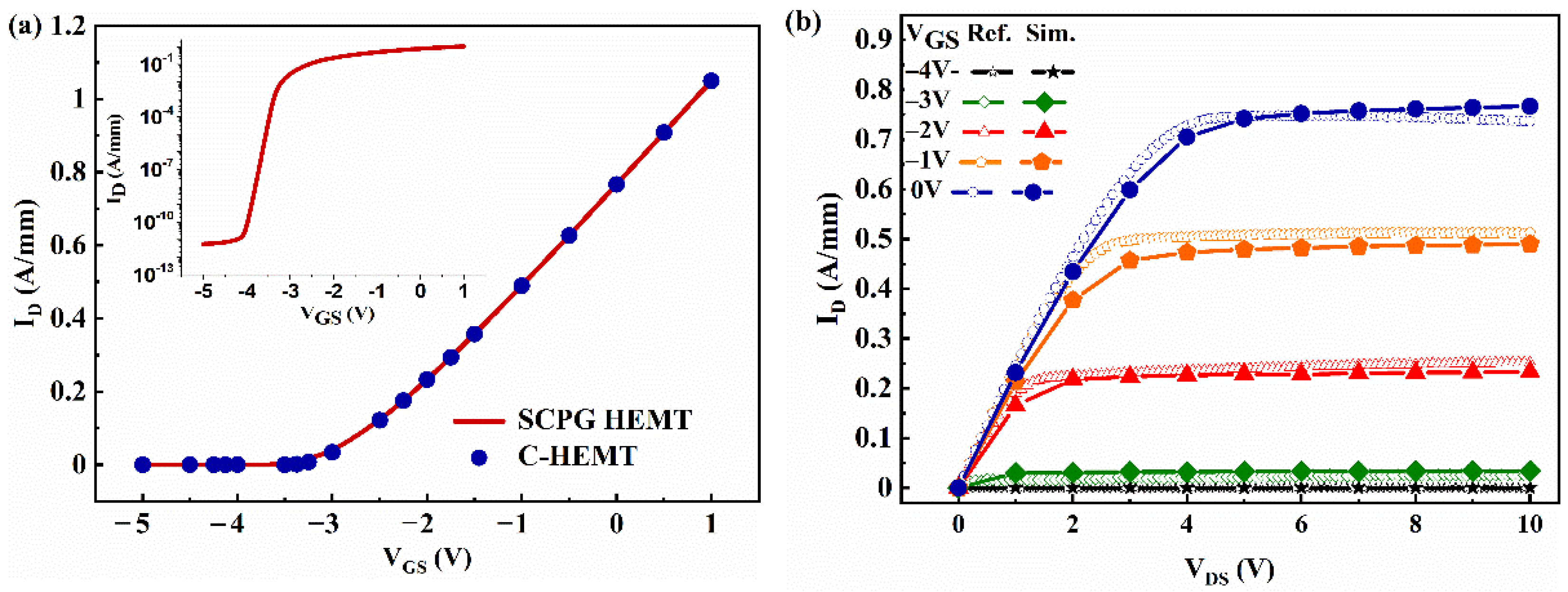

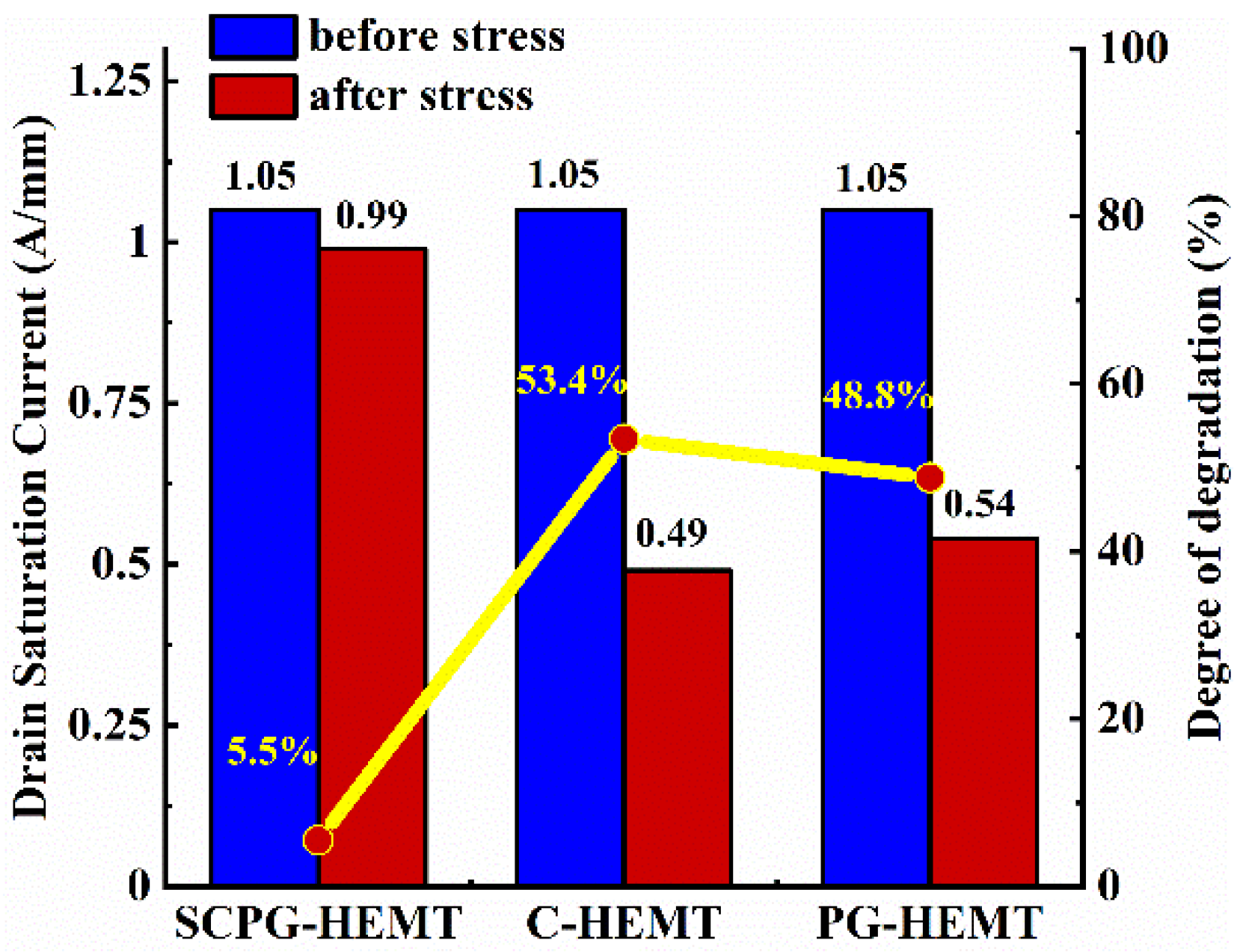

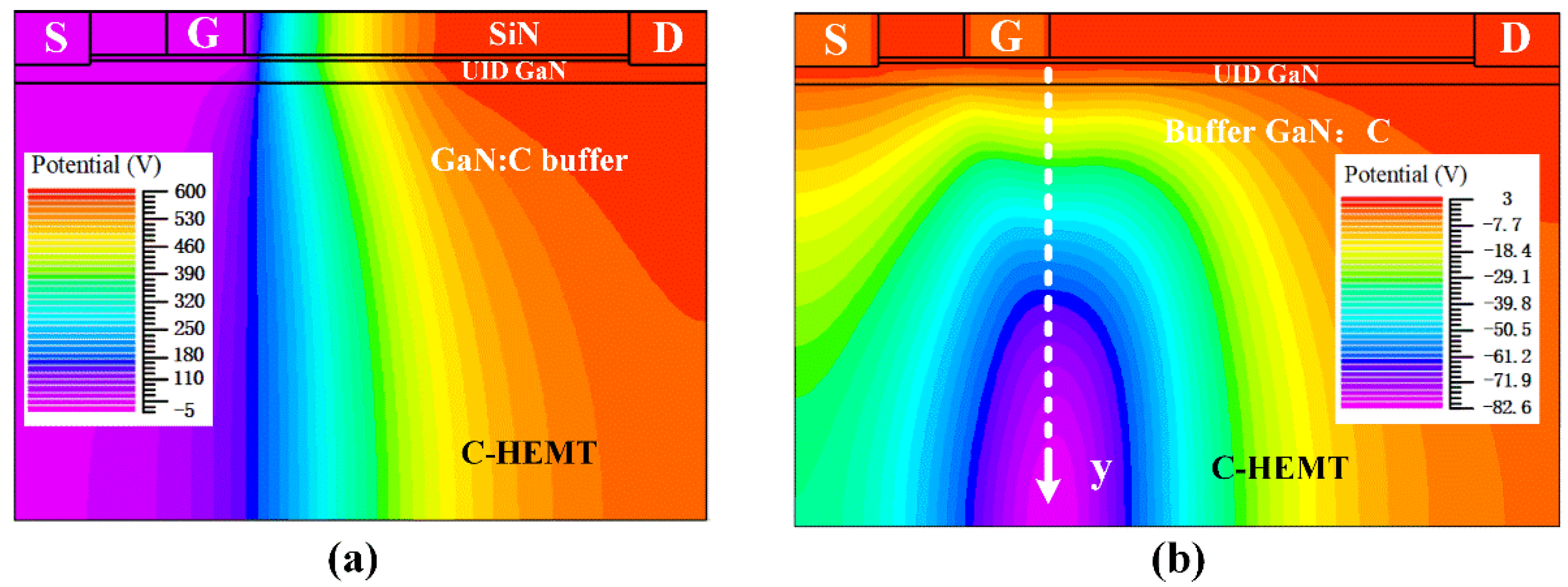
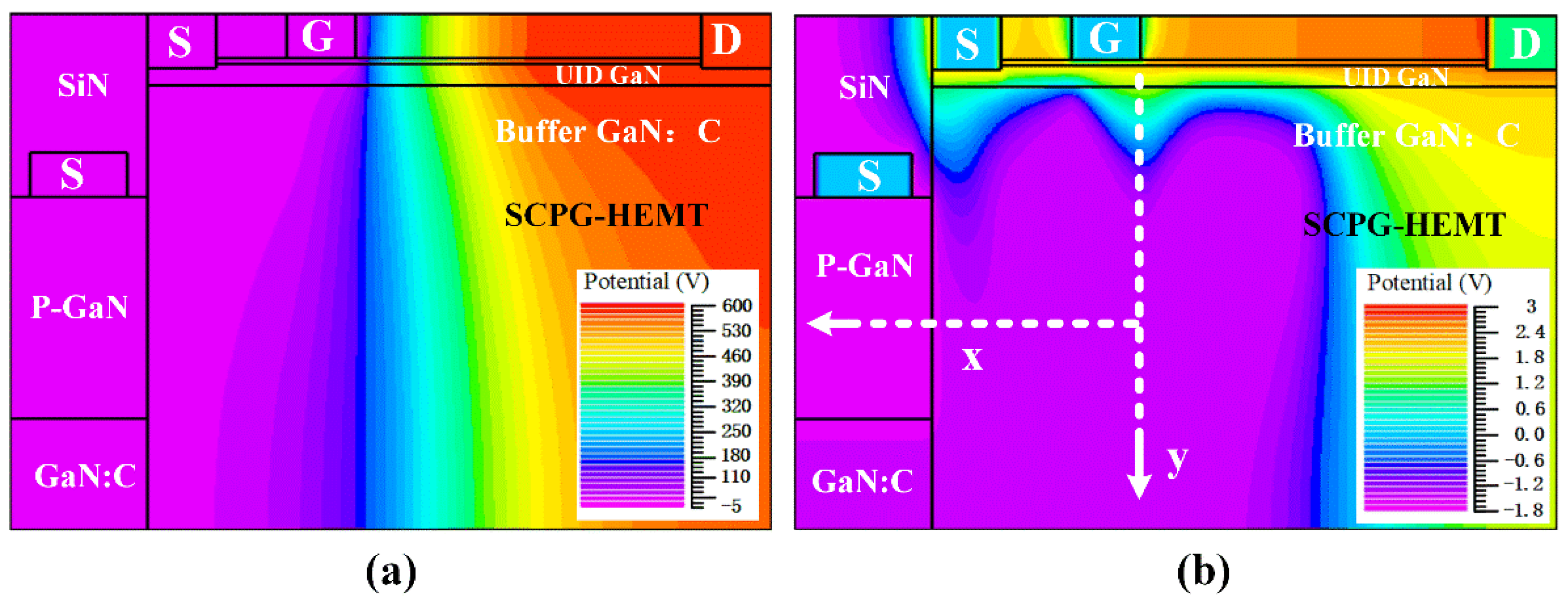
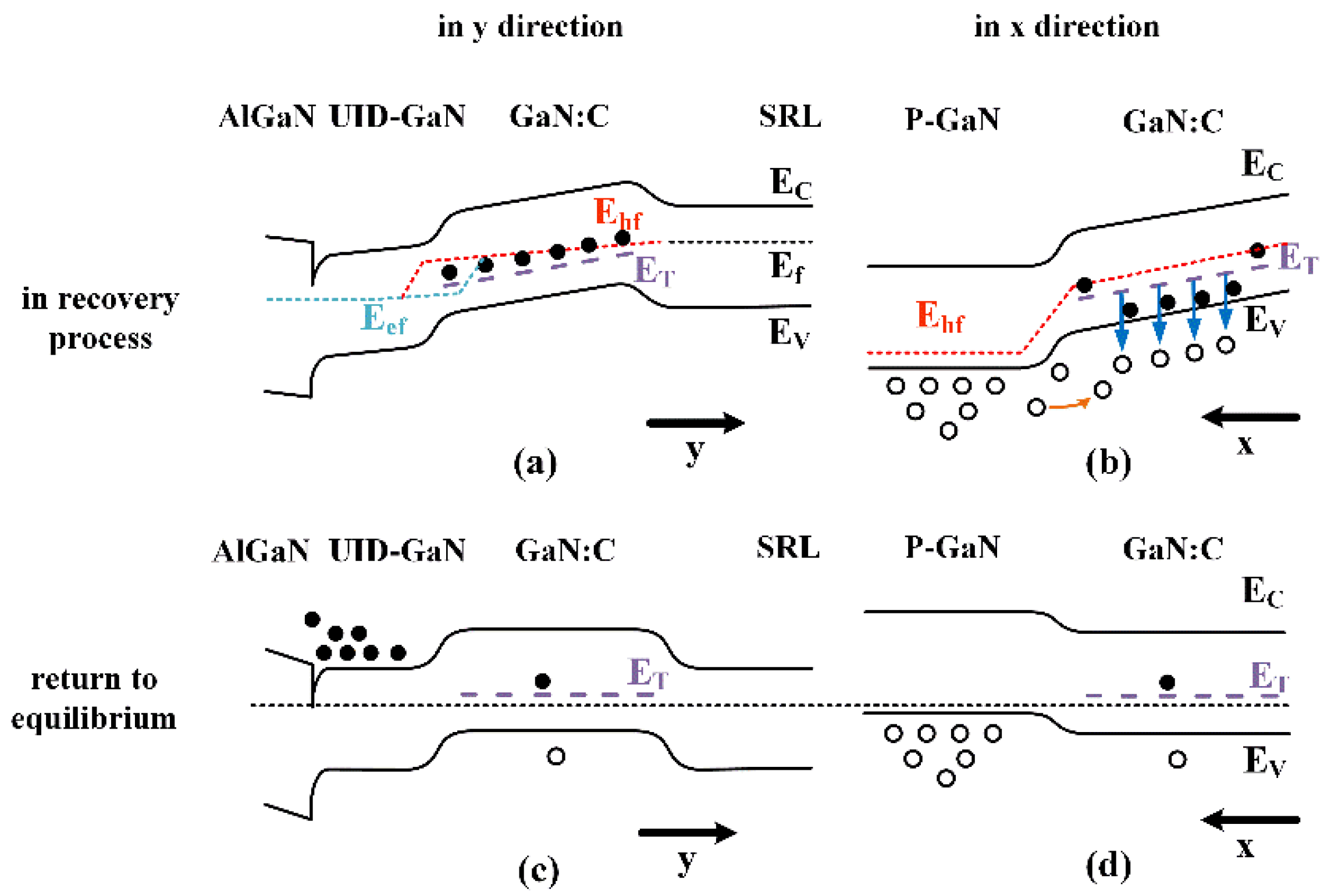
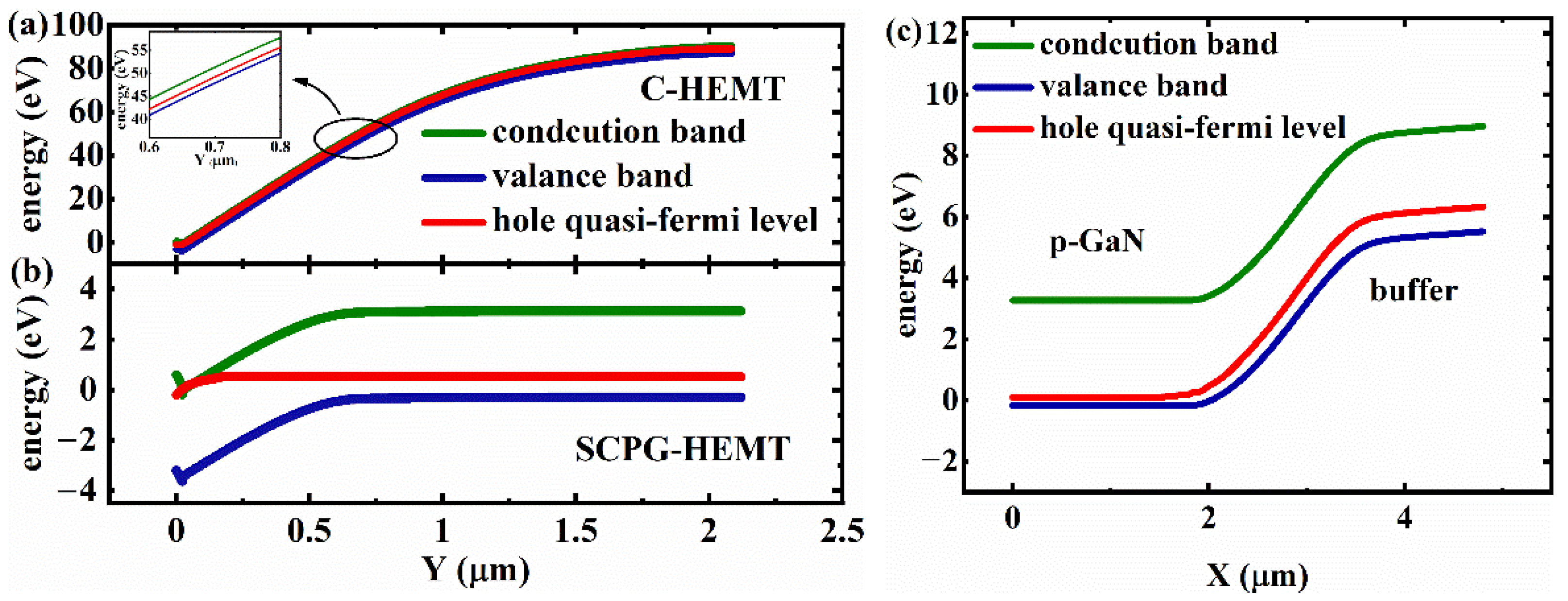

| Parameters | Values | Units |
|---|---|---|
| Schottky barrier height | 1.02 | eV |
| Polarization charge density | 1.1 × 1013 | cm–2 |
| Hole density in SCPG | 5 × 1017 | cm–3 |
| Mobility of 2DEG | 2000 | cm2/v·s |
| Mobility of electron | 800 | cm2/v·s |
| Mobility of hole | 10 | cm2/v·s |
| Source and Drain ohmic contact resistance | 0.5 | Ω·mm |
| Contact resistance of p-GaN ohmic contact | 50 | Ω·mm |
| Trap energy level Et from valance band | 0.86 | eV |
| Concentration of acceptor traps Nt | 5 × 1017 | cm–3 |
| Capture cross section of traps | 1 × 10–15 | cm2 |
| Degeneracy factor D of traps | 1 | - |
Publisher’s Note: MDPI stays neutral with regard to jurisdictional claims in published maps and institutional affiliations. |
© 2021 by the authors. Licensee MDPI, Basel, Switzerland. This article is an open access article distributed under the terms and conditions of the Creative Commons Attribution (CC BY) license (https://creativecommons.org/licenses/by/4.0/).
Share and Cite
Lin, W.; Wang, M.; Sun, H.; Xie, B.; Wen, C.P.; Hao, Y.; Shen, B. Suppressing Buffer-Induced Current Collapse in GaN HEMTs with a Source-Connected p-GaN (SCPG): A Simulation Study. Electronics 2021, 10, 942. https://doi.org/10.3390/electronics10080942
Lin W, Wang M, Sun H, Xie B, Wen CP, Hao Y, Shen B. Suppressing Buffer-Induced Current Collapse in GaN HEMTs with a Source-Connected p-GaN (SCPG): A Simulation Study. Electronics. 2021; 10(8):942. https://doi.org/10.3390/electronics10080942
Chicago/Turabian StyleLin, Wei, Maojun Wang, Haozhe Sun, Bing Xie, Cheng P. Wen, Yilong Hao, and Bo Shen. 2021. "Suppressing Buffer-Induced Current Collapse in GaN HEMTs with a Source-Connected p-GaN (SCPG): A Simulation Study" Electronics 10, no. 8: 942. https://doi.org/10.3390/electronics10080942
APA StyleLin, W., Wang, M., Sun, H., Xie, B., Wen, C. P., Hao, Y., & Shen, B. (2021). Suppressing Buffer-Induced Current Collapse in GaN HEMTs with a Source-Connected p-GaN (SCPG): A Simulation Study. Electronics, 10(8), 942. https://doi.org/10.3390/electronics10080942







